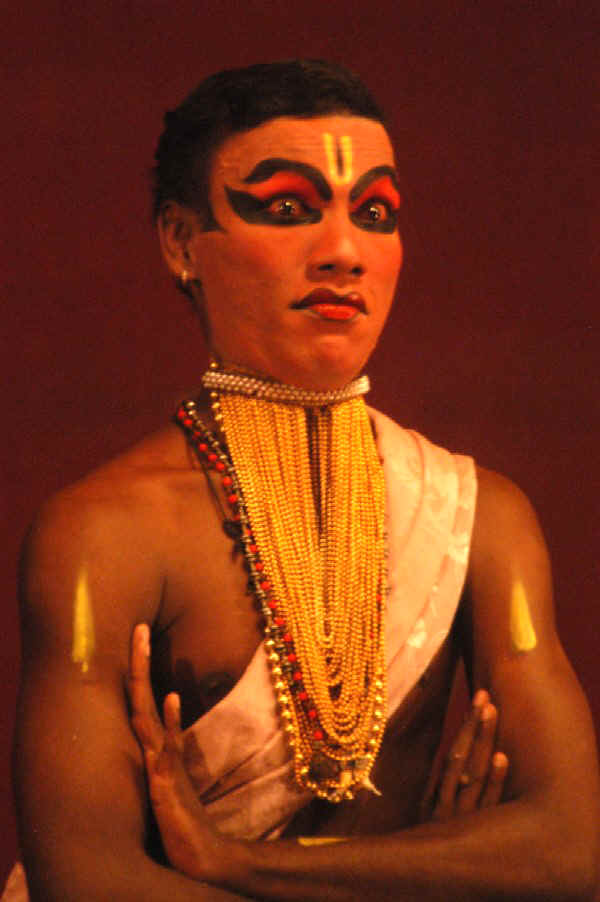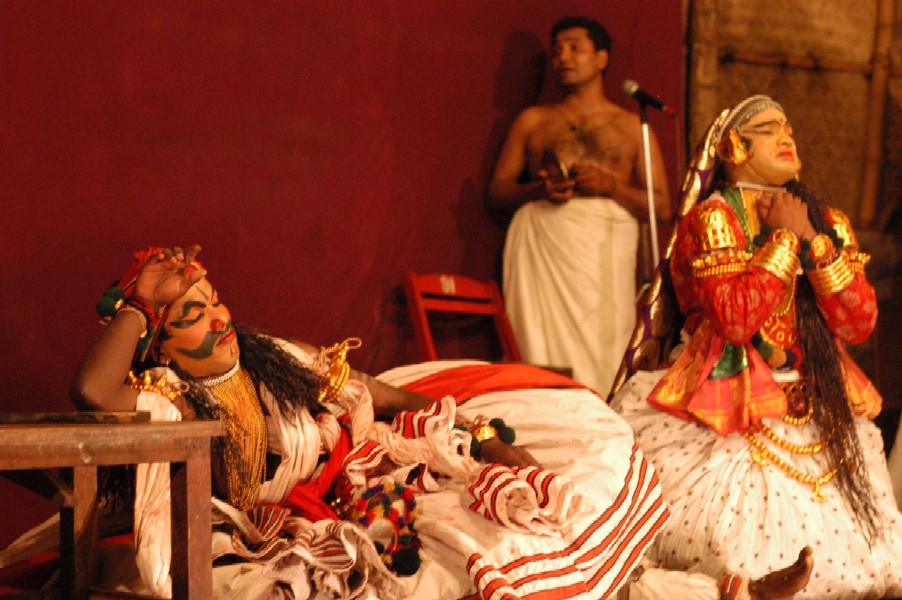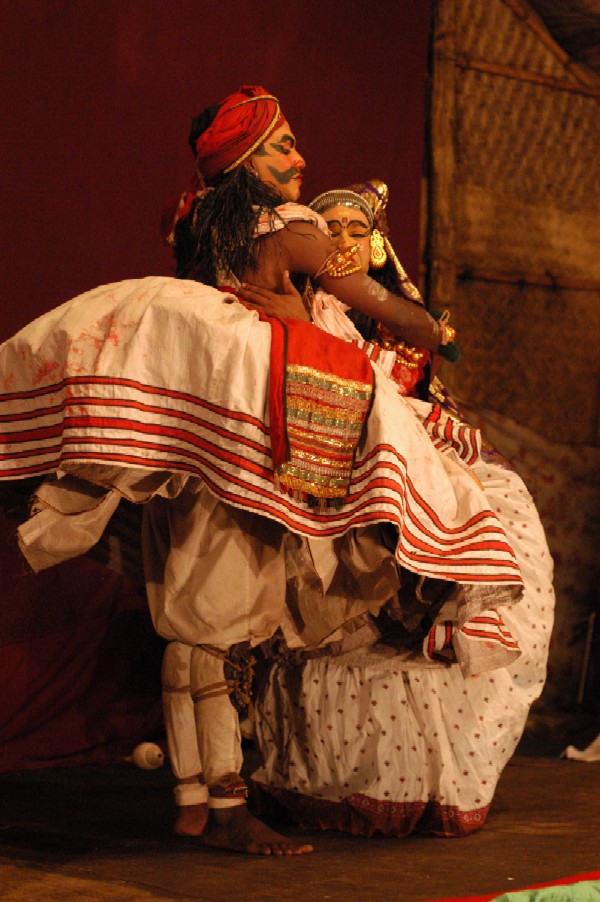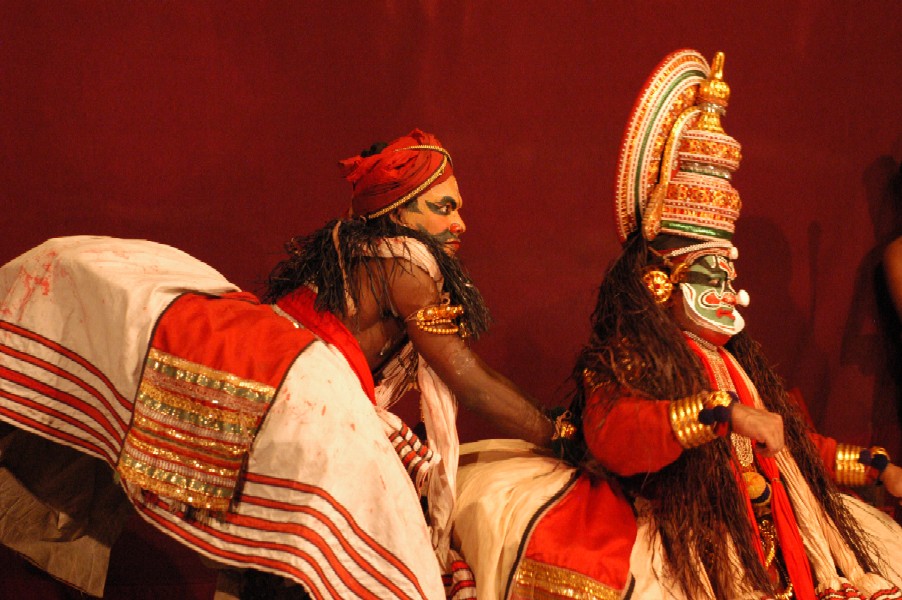November 16. KOCHI "The Colors of Kathakali Theater" After spending a couple of days walking the streets of Fort Cochin we decided to go for a touristy performance of Kathakali, an uniquel y Kerelan stage drama based on stories from the Indian epics. It is thought to have its roots in ancient drama methods from the 2nd century AD but the contemporary version dates back to the 17th century. The term "kath" refers to the "storytelling" while "kali" refers to "song". The drama is performed by elaborately costumed male actors while a singer and musicians narrated the story from the background. y Kerelan stage drama based on stories from the Indian epics. It is thought to have its roots in ancient drama methods from the 2nd century AD but the contemporary version dates back to the 17th century. The term "kath" refers to the "storytelling" while "kali" refers to "song". The drama is performed by elaborately costumed male actors while a singer and musicians narrated the story from the background.
There were several theaters around the Fort Cochin/ Ernakulum area but we were swayed towards the Kerela Kathakali Center in its cozy little venue along the waterfront in Fort Cochin. We went to get our seats early, which was a good thing, and were actually assigned seat numbers for the small theater (someone should put these people in touch with that dance theater in Kandy!). The performance was scheduled to start at 6:30 but the makeup started at 5:00. A more traditional performance could go all night long but the touristy performances were designed to give visitors a taste of this elaborate and colorful art form. For the uninitiated, watching the actors go through the ritual of applying their makeup was almost as entertaining as the drama itself. We arrived at 5:30 and were welcomed by lacy designs scattered along the walkway leading into the theater. They were made by pouring flour through small stencils. The theater was a small structu re made of woven mat walls and a simple stage. It was equipped with ceiling fans and hand fans to help people keep cool. When we arrived we found the actors already sitting on stage with mirrors and bowls of face paints, already engaged in their preparations. The transformation was quite remarkable. The makeup covered the actors faces completely and created fantastic characters that jumped right out of the pages of the Mahabarata, the source of that night's performance. re made of woven mat walls and a simple stage. It was equipped with ceiling fans and hand fans to help people keep cool. When we arrived we found the actors already sitting on stage with mirrors and bowls of face paints, already engaged in their preparations. The transformation was quite remarkable. The makeup covered the actors faces completely and created fantastic characters that jumped right out of the pages of the Mahabarata, the source of that night's performance.
Gradually the little theater came to life as more and more guests arrived and little oil lamps around the stage were lit by a stage hand. The actors disappeared in their various states of makeup preparation and the narrator and musicians took the stage. The narrator began with an demonstration of the makeup used by the actors. The yellow and red colors were ground from natural stones and combined with coconut oil. He took a gray-looking stone, dipped it in coconut oil, and rubbed it against an second stone. It yielded a bright red paste. Using a different stone provided a bright yellow paste. From one of the oil lamps he lifted a third rock and showed how the soot gave them the color black. He then picked up a tiny seed that came from a flower and showed how the actors placed the seed in their eyes temporarily to give their eyes a slightly reddish hue. Then, lastly, he held up a bowl of rice paste that we had seen used to secure pieces of paper to the face of one actor. The different makeup coloring used by the actors was determined by their character. If they used a lot of green the character was good. If they used red he was a bad character. Black was for demons and yellowish colors represented female characters. But the explanation of this symbolic art was just beginning. represented female characters. But the explanation of this symbolic art was just beginning.
An actor appeared on stage and responded as the narrator explained the various movements used in Kathakali. He was seated in the middle of the stage, shirtless with strings of gold beaded strands hang around his neck. He wore baggy pants with a green sarong over the top and anklets with rows of bells. He face was made up with light flesh colored paint, bold red lips, and dramatic black markings around his eyes. The narrator began with a description of the various eye movements - up, down, around, side to side, crossed eyed, and a completely unnatural quivering of his pupils. All of the movements were exaggerated and he moved his eyes to the beat of the drummer. Big beat (UP), big beat (DOWN), a swish of the skin (AROUND), small vibrating beat (PUPIL SHAKE). The rest of his body stayed totally still and his face was otherwise motionless.
The narrator then moved on to described the facial gestures, which were even more remarkable. I was always impressed with people that could move their eye brows independently but this guy seemed to have command over every muscle in his face! Not only could he move each eye brown on its own but he could move each cheek on its own and could make almost anything twitch to the music. He had his cheeks quivering, then his mouth, then his eye brows moved. Then he combined the eye movements with the face movements and added head movements. All together these gestures created a kind of Kathakali language and there were nine different meanings, each with its own combination -- love, sarcasm, sadness, anger, bravery, fear, repulsion, wonder, and peace. The actor was hardly moving but it looked exhausting. The sweat dripping down his cheeks told me that it was exhausting.
Then, to make things even more complicated, they added the mudras, or hand gestures. The term is commonly used to refer to the hand positions of Hindu and Buddhist figures. There were twenty-four different mudras that were combined with various body movements and the head/face/eye gestures to create a more elaborate language. With these movement combos the language encompassed both words and sentences. The gestures could represent things, like the moon, the sun, a cobra, eyes, lips, or the face, or they could mean places, like here or there. They could also indicate people like a king, an empress, family members, you, or me. Then they became more complex and could demonstrate a  ctions like 'a bee sucking nectar from a lotus', eating, or 'I am going'. With greater intensity the language conveyed commands like 'Please come!', 'Please go!', 'Come here!', or 'Go away!' or allowed characters to exchange questions and answers like 'How are you?', and 'I am fine', or just simply 'yes', 'no', or 'sure'. And all of this was done in a relatively stationary place. The stage was quite small but this symbolic drama didn't need so much space to relate its story. After this thorough demonstration it was easy to see how it could take a performer six years of training to learn his art. The actors, narrators, and musicians all took six years while the makeup artists took four years. ctions like 'a bee sucking nectar from a lotus', eating, or 'I am going'. With greater intensity the language conveyed commands like 'Please come!', 'Please go!', 'Come here!', or 'Go away!' or allowed characters to exchange questions and answers like 'How are you?', and 'I am fine', or just simply 'yes', 'no', or 'sure'. And all of this was done in a relatively stationary place. The stage was quite small but this symbolic drama didn't need so much space to relate its story. After this thorough demonstration it was easy to see how it could take a performer six years of training to learn his art. The actors, narrators, and musicians all took six years while the makeup artists took four years.
The two scenes of the Mahabarata that were performed were from the "Kichaka Vadha" (The Death of Kichaka). We were handed a small translation for our reference which, along with the detailed introduction to Kathakali we had received from the narrator, made the performance much more meaningful. The vivid colors of the costume and makeup could have kept a first-timer engaged for a while but the subtly of the art would ultimately have been lost on them. As it was I found myself consulting my notes during the performance and trying to reconcile the paper translation with the movement definitions we had learned. It made the hour and half go by very quickly. Only two actors performed, with one playing a different character in each scene. The first character to appear on stage was Kichaka, the brother of Sudeshana and Commander-in-Chief of Virata's forces. He was the most elaborately dressed character with a towering headdress, a layered bouffant skirt, and striking makeup that was accented with the paper attachments. The features of the actor underneath were totally unrecognizable. In the first scene Kichaka was joined by Malini, wife of the five Pandavas who was disguised as the maidservant Draupadi. In the second scene Kichaka met Valala, the second Pandava who was disguised as the cook Bhima. Below is the translation we were given for the show. elaborately dressed character with a towering headdress, a layered bouffant skirt, and striking makeup that was accented with the paper attachments. The features of the actor underneath were totally unrecognizable. In the first scene Kichaka was joined by Malini, wife of the five Pandavas who was disguised as the maidservant Draupadi. In the second scene Kichaka met Valala, the second Pandava who was disguised as the cook Bhima. Below is the translation we were given for the show.
KICHAKA VADHA
(Scene I)
Narrator: Kichaka waited, with impatience, at the window "dressed to kill". He licked his lips in anticipation and greeted her with a voice of oil.
Kichaka: Oh jewel among jewels. Oh precious one. You honor me with this visit along. Let me massage your legs and feet. They must be tired, so far you have come. And to think that all along you've come here. Increasing my place's sanctity. In this flower-filled room we're along, at last. Come rest on my cot, oh my beautiful wife. Come into my arms and hold me fast. Together we'll find joy unsurpassed.
 Malini: What? Are you mad? You offspring of Sudha. You low minded beast, foul-mouthed seducer! I've come on an errand for your sister. She asked me to fetch some rice and liquor. Now please be so kind as to give it to me. Such talk is insulting. Its also useless. Malini: What? Are you mad? You offspring of Sudha. You low minded beast, foul-mouthed seducer! I've come on an errand for your sister. She asked me to fetch some rice and liquor. Now please be so kind as to give it to me. Such talk is insulting. Its also useless.
Kichaka: (Ah ha) She sits and claws like a cat. One thing is certain, there is no two ways about it. I'll have you, come what may.
(Note: Kichaka tries to force himself on her. She fights back and runs. He chases her and finally, made with desire, strikes her. And kicks her.)
(Scene II)
Narrator: Crushed in body and spirit, hurt, insulted and weeping, Draupadi ran home to the kitchen of the palace, where Bhima was sleeping. She shook him until he awoke and told him the dreadful story of Kichak's infamy. Choking with sobs she could not control and in a voice that broke. At each word she told him in full.
Malini: Oh my protector, my gracious lord. That hateful Kichaka tried to seduce me. And when I refused his rude advances he hit me and kicked me and tried to seduce  me. Oh it was horrible. Only good karma or a miracle saved me from his blows. me. Oh it was horrible. Only good karma or a miracle saved me from his blows.
Valala: Try to calm yourself, beautiful wife. Your dreadful ordeal is over at last. Be firm and weep no more. His life will be over soon. As Jedasura, and many other demon has died by my hand, so will this find Kichaka. Does the wind that breaks great trees have trouble moving dust off. He'll fall by my hand. Oh beloved, ask him to meet your attention. Tonight in the dance hall. I'll wait there and then...
Narrator: With Bhima's suggestion in mind Draupadi sought her tormentor, who quickly accepted her kind invitation to meet her. He went to the pitch-dark dance hall and finding somebody there, blind with desire and darkness, spoke passionately to "her".
Kichaka: Oh innocent beautiful sweet Malini. Why don't you speak? Can you not see me? Are you sleeping? Your body as soft as a slender young bud. Ahhh! It feels like a rock. My god! But surely it must be Malini....?
(Note: Kichaka feels Valala's body underneath a cover. Valala attacks Kichaka and ends the scene with choking him to death.)
The costumes were all well suited to the characters. Kichaka looked like an over-inflated, self-obsessed, ego maniac. Malini was the delicate woman with long hair and jewels while her husband, Valala, was the masculine hero. They were classic characters but didn't actually speak at all during the performance. Only Kichaka, the most engaging character, grunted as he insisted that Malini give herself to him. The two short scenes became an hour and half performance of intense and energetic drama, all conveyed through symbolic gestures. was the delicate woman with long hair and jewels while her husband, Valala, was the masculine hero. They were classic characters but didn't actually speak at all during the performance. Only Kichaka, the most engaging character, grunted as he insisted that Malini give herself to him. The two short scenes became an hour and half performance of intense and energetic drama, all conveyed through symbolic gestures. |
SRI LANKA
Colombo
Oct 25
Oct 26
Oct 27-29
Nuwara Eliya
Oct 30
Oct 31
Kandy
Nov 1-5 (1)
Nov 1-5 (II)
Polonnaruwa
Nov 6
Sigiriya & Dambulla
Nov 7
Colombo
Nov 8
INDIA
Ft.Cochin
Nov 9-15 (I)
Nov 9-15 (II)
Nov 16
Nov 17-18
Madurai
Nov 19
Nov 20
Tiruchirapalli
Nov 21
Nov 22
Nov 23
Chennai
Nov 24
Nov 25-26
Nov 27-28
Ft.Cochin
Nov 29
Lakshadweep
Nov 30-Dec 4 (I)
Nov 30-Dec 4 (II)
Trans-India Train
Dec 5-7 (I)
Dec 5-7 (II)
Siliguri
Dec 8
Darjeeling
Dec 9
Dec 10-13
Dec 14
Sikkim
Dec 15
Dec 16-20
Dec 21-23
Dec 24
Dec 25
Darjeeling
Dec 26
Dec 27-Jan 2
Siliguri
Jan 3
Jaigon
(Bhutan)
Jan 4
Kolkata
Jan 5-6
THAILAND
Bangkok
Jan 6-13 (I)
Jan 6-13 (II)
Jan 6-13 (III)
|

